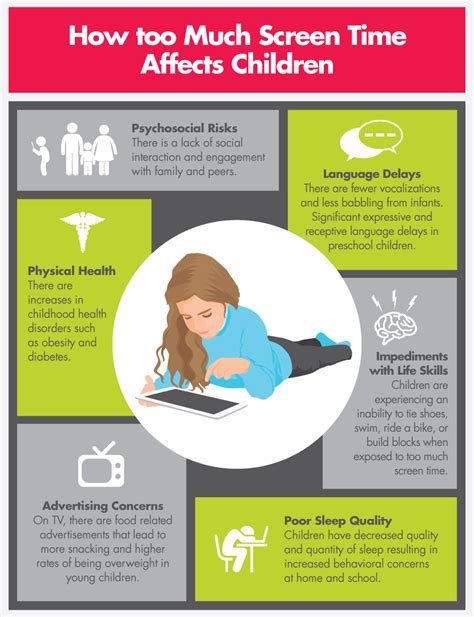The Impact of Screen Time on Children’s Mental and Physical Health
In today’s digital age, screen time has become a ubiquitous part of children’s lives. Whether it’s watching TV, playing video games, or using smartphones and tablets, children are spending more and more time in front of screens. While technology offers many benefits, excessive screen time can have negative effects on children’s mental and physical health. In this blog post, we will delve into the concept of screen time and its impact on children. We will explore the detrimental effects of excessive screen time on mental health, including its influence on social development and sleep patterns. Additionally, we will discuss the link between screen time and physical health, specifically its correlation with obesity. Moreover, we will provide strategies for managing and limiting screen time, as well as promoting a healthy balance between screen time and physical activity. Ultimately, our goal is to educate parents and caregivers about responsible screen time use and its importance in maintaining children’s overall well-being.
Understanding the concept of screen time
Screen time refers to the amount of time individuals spend looking at various screens, including television, computers, tablets, and smartphones. It encompasses both recreational and educational screen use, and has become a prevalent part of modern life.
Understanding the concept of screen time is essential in today’s digital age, as it has a significant impact on various aspects of our lives, including physical health, mental health, social development, and overall well-being.
It is important to recognize that not all screen time is created equal. While some screen time can be educational and interactive, excessive screen time can have detrimental effects on individuals, particularly children and adolescents.
By understanding the concept of screen time, individuals can make informed decisions about their technology use and work towards achieving a healthy balance in their digital consumption.
The negative effects of excessive screen time
Excessive screen time has become a major concern in today’s digital age, with more and more people, especially children and teenagers, spending excessive amounts of time in front of screens. The negative effects of this phenomenon are well-documented, and they can have a significant impact on both physical and mental health.
Eye strain is one of the most common negative effects of excessive screen time. Staring at a screen for prolonged periods can lead to discomfort, blurred vision, and headaches. This can be particularly damaging for young children whose eyes are still developing.
In addition to eye strain, excessive screen time can also lead to sedentary behavior and a lack of physical activity. This can contribute to an increased risk of obesity, as well as other health issues such as heart disease and diabetes.
Mental health can also be affected by excessive screen time, with studies showing a correlation between high levels of screen time and an increased risk of anxiety and depression in children and teenagers. The constant exposure to social media and unrealistic images can also lead to decreased self-esteem and poor body image.
How screen time affects children’s mental health
Children today are spending more time in front of screens than ever before. With the rise of smartphones, tablets, and video games, the amount of screen time has increased exponentially. Unfortunately, this excessive exposure to screens can have a detrimental effect on children’s mental health.
One of the most concerning aspects of excessive screen time is the impact it can have on children’s emotional well-being. Studies have shown that children who spend more time in front of screens are more likely to experience symptoms of depression and anxiety. This is especially true for adolescents, whose developing brains are particularly susceptible to the negative effects of screen time.
Furthermore, excessive screen time has been linked to a decrease in empathy and social skills in children. When kids spend too much time on devices, they have less opportunity to engage in face-to-face interactions and develop important social and emotional skills. This can lead to difficulties in forming meaningful relationships and navigating social situations.
It’s important for parents and caregivers to be aware of the potential impact of screen time on children’s mental health and to take steps to limit their exposure. Encouraging outdoor play, setting screen time limits, and promoting activities that promote creativity and imagination can all contribute to a healthier digital balance for kids.
Screen time’s impact on physical health
The impact of screen time on physical health is becoming increasingly concerning as technology continues to advance and become more integrated into our daily lives. Excessive screen time has been linked to a number of health issues, including the risk of obesity, poor posture, and an increased likelihood of developing musculoskeletal problems.
With the rise of smartphones, tablets, and computers, children and adults alike are spending more time engaged with screens and less time being physically active. This sedentary behavior can have detrimental effects on our physical well-being, leading to an increased risk of conditions such as diabetes, heart disease, and stroke. Furthermore, prolonged screen time has been associated with decreased bone density and an increased risk of developing cardiovascular problems.
It is important for individuals and families to be aware of the potential consequences of excessive screen time and take proactive measures to mitigate these risks. Encouraging regular physical activity, setting limits on screen time, and promoting a healthy balance between technology use and outdoor play can help to safeguard against the negative impact of excessive screen time on physical health.
Ultimately, by understanding and addressing the impact of screen time on physical health, we can work towards promoting healthier lifestyles and reducing the prevalence of screen-related health issues in our society.
The link between screen time and obesity
It’s no secret that our society is becoming increasingly dependent on screen time, whether it’s through smartphones, computers, or television. However, what many people fail to realize is the potential link between excessive screen time and obesity. Research has shown that the more time an individual spends sitting in front of a screen, the less physically active they are likely to be. This sedentary behavior can contribute to weight gain and an increased risk of obesity.
One of the main reasons for the link between screen time and obesity is the decrease in physical activity that often accompanies prolonged periods of sitting in front of a screen. Whether it’s children spending hours playing video games or adults binge-watching TV shows, the lack of movement and exercise can lead to weight gain over time. Additionally, excessive screen time can also result in poor eating habits, as it is often associated with mindless snacking and consumption of unhealthy foods.
Furthermore, the impact of screen time on obesity is not only limited to the individual level but also extends to a societal level. As more and more people, especially children, spend a significant amount of time in front of screens, the overall health of the population is at risk. The prevalence of obesity and related health issues is on the rise, and excessive screen time plays a significant role in this concerning trend.
Overall, it is clear that there is a strong connection between screen time and obesity. As such, it is imperative for individuals and families to be mindful of their screen time habits and make a concerted effort to incorporate more physical activity into their daily routines. By doing so, they can work towards promoting a healthier lifestyle and reducing the risk of obesity and its associated health complications.
Screen time’s influence on sleep patterns
Screen time, referring to the amount of time spent in front of electronic devices, has been found to have a significant impact on sleep patterns. The increased use of screens, such as smartphones, tablets, and computers, has been linked to delayed bedtimes, reduced total sleep time, and poor sleep quality.
Research has shown that the blue light emitted from screens can interfere with the body’s natural sleep-wake cycle, also known as the circadian rhythm. Exposure to this type of light, especially in the evening, can suppress the production of melatonin, a hormone that helps regulate sleep.
Furthermore, the use of screens before bedtime can stimulate the brain, making it more difficult to wind down and fall asleep. This is particularly problematic for children and adolescents, as they are more vulnerable to the effects of screen time on sleep.
To mitigate the negative influence of screen time on sleep patterns, it is important for individuals, especially young people, to establish a bedtime routine that includes limiting screen use at least an hour before sleep, creating a relaxing environment, and engaging in calming activities, such as reading or meditating.
The role of screen time in social development
In today’s digital age, screen time plays a significant role in shaping the social development of children and adolescents. With the prevalence of social media platforms, online gaming, and virtual communication, young individuals are increasingly relying on screens to interact with their peers and the world around them.
However, excessive screen time can have negative implications on social development. Children who spend an excessive amount of time in front of screens may struggle to develop essential social skills such as empathy, communication, and conflict resolution. Moreover, prolonged screen time can lead to an increased risk of social isolation and feelings of loneliness.
On the other hand, moderate and purposeful use of screens can also contribute to positive social development. Online platforms provide opportunities for young individuals to connect with like-minded peers, engage in collaborative projects, and gain exposure to diverse perspectives and cultures.
As parents, caregivers, and educators, it is crucial to promote a healthy balance between screen time and offline social interactions. Encouraging face-to-face communication, organizing group activities, and setting screen time limits can help support the development of strong social skills and meaningful connections in children and adolescents.
Strategies for managing and limiting screen time
In today’s digital age, managing and limiting screen time for both children and adults has become increasingly important. With the widespread use of smartphones, tablets, computers, and televisions, it’s essential to implement effective strategies to ensure that screen time does not become excessive.
One strategy for managing and limiting screen time is to set clear and consistent rules. Establishing specific time limits for daily screen use can help individuals regulate their technology consumption. For example, parents may decide to limit their child’s screen time to one hour per day, while adults may set aside designated periods for checking emails and browsing social media.
Another effective strategy is to encourage alternative activities that do not involve screens. This can include engaging in outdoor sports, hobbies, or creative pursuits. By promoting a healthy balance between screen time and physical activities, individuals can reduce their reliance on electronic devices and enhance their overall well-being.
Additionally, practicing mindfulness and digital detoxing can be beneficial in managing and limiting screen time. Taking regular breaks from screens, practicing meditation, and engaging in offline activities can help individuals develop a healthier relationship with technology and reduce the negative effects of excessive screen time.
Promoting a healthy balance between screen time and physical activity
In today’s digital age, it is becoming increasingly important to find a balance between screen time and physical activity for individuals of all ages. With the rise of technology and the prevalence of electronic devices, many people, especially children, are spending more time in front of screens and less time engaging in physical activities. This shift in behavior has significant implications for overall health and well-being.
One of the key strategies for promoting a healthy balance between screen time and physical activity is to set clear guidelines and boundaries for screen time use. This involves establishing designated screen-free times, such as during meals and before bedtime, and limiting the total amount of screen time allowed each day. By offering alternatives and scheduling physical activities, individuals can avoid over-reliance on electronic devices.
Additionally, it is essential to educate individuals, particularly parents and caregivers, about the importance of physical activity and the potential risks associated with excessive screen time. By raising awareness about the benefits of physical activity, such as improved cardiovascular health, enhanced mood, and better sleep patterns, individuals can be encouraged to prioritize physical activity over sedentary screen time.
Furthermore, creating opportunities for enjoyable and engaging physical activities, such as sports, outdoor play, and active hobbies, can help individuals develop a positive association with physical activity. By making physical activity fun and rewarding, individuals are more likely to choose it over screen time, leading to a healthier balance in their daily routines.
Educating parents and caregivers about responsible screen time use
In today’s digital age, it is essential for parents and caregivers to be knowledgeable about responsible screen time use. With the widespread use of smartphones, tablets, and computers, children are exposed to screens from a very young age. It is crucial for adults to understand the potential impact of excessive screen time on children’s development and well-being.
Educating parents and caregivers about responsible screen time use involves providing them with information about the potential negative effects of excessive screen time. These effects can include increased risk of obesity, diminished social skills, and disrupted sleep patterns. By understanding these potential consequences, adults can make informed decisions about how to limit their children’s screen time in a way that promotes a healthy balance.
Furthermore, it is important to provide parents and caregivers with strategies for managing and limiting screen time. This may include setting clear limits on usage, monitoring the content that children are exposed to, and promoting alternative activities such as outdoor play and reading. By empowering adults with practical strategies, they can take an active role in promoting responsible screen time use in their households.
Overall, educating parents and caregivers about responsible screen time use is crucial in today’s digital world. By providing them with information about the potential negative effects and strategies for management, adults can make informed decisions that promote a healthy balance between screen time and other activities.
Frequently Asked Questions
What is the concept of screen time?
Screen time refers to the amount of time spent using digital devices such as smartphones, tablets, computers, and televisions.
What are the negative effects of excessive screen time on children?
Excessive screen time has been associated with decreased physical activity, obesity, poor sleep quality, decreased social interaction, and negative impacts on mental health.
How does screen time affect children’s mental health?
Excessive screen time has been linked to mental health issues such as anxiety, depression, and attention problems in children.
What is the impact of screen time on children’s physical health?
Screen time has been linked to sedentary behavior, decreased physical activity, and an increased risk of obesity and related health issues in children.
How is screen time linked to obesity in children?
Excessive screen time is associated with unhealthy eating habits, decreased physical activity, and increased sedentary behavior, all of which contribute to the development of obesity in children.
How does screen time influence the sleep patterns of children?
Excessive screen time, especially before bedtime, can lead to disrupted sleep patterns, difficulty falling asleep, and overall poor quality of sleep in children.
What are some strategies for managing and limiting screen time for children?
Setting limits on screen time, encouraging physical activity, promoting other recreational activities, establishing tech-free zones in the home, and using parental control settings are effective strategies for managing and limiting screen time for children.
How can parents and caregivers promote a healthy balance between screen time and physical activity for children?
Parents and caregivers can encourage outdoor play, sports participation, and recreational activities, as well as setting a positive example by limiting their own screen time and engaging in physical activities with their children.






